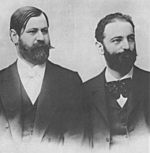Wilhelm Fliess facts for kids
Quick facts for kids
Wilhelm Fliess
Wilhelm Fließ |
|
|---|---|

Fliess (right) and Sigmund Freud
in the early 1890s. |
|
| Born | 24 October 1858 Arnswalde, Province of Brandenburg, Kingdom of Prussia
|
| Died | 13 October 1928 (aged 69) Berlin, Province of Brandenburg, Germany
|
| Nationality | Prussian |
| Scientific career | |
| Fields | Otolaryngology |
Wilhelm Fliess (German: Wilhelm Fließ; 24 October 1858 – 13 October 1928) was a German otolaryngologist who practised in Berlin. He developed the pseudoscientific theory of human biorhythms and a possible nasogenital connection that have not been accepted by modern scientists. He is today best remembered for his close friendship and theoretical collaboration with Sigmund Freud.
Contents
Career
Fliess developed several idiosyncratic theories, such as "vital periodicity", forerunner of the popular concepts of biorhythms. His work never found scientific favour, but some of his thinking, such as the idea of innate bisexuality, was incorporated into Freud's theories.
On Josef Breuer's suggestion, Fliess attended several conferences with Sigmund Freud beginning in 1887 in Vienna, and the two soon formed a strong friendship. Through their extensive correspondence and the series of personal meetings, Fliess came to play an important part in the development of psychoanalysis. Together, Fliess and Freud developed a Project for a Scientific Psychology, which was later abandoned. Fliess wrote about his biorythmic theories in Der Ablauf des Lebens.
Emma Eckstein (1865–1924) had a particularly disastrous experience when Freud referred the then 27-year-old patient to Fliess for surgery to remove the turbinate bone from her nose, ostensibly to cure her of premenstrual depression. Eckstein haemorrhaged profusely in the weeks following the procedure, almost to the point of death as infection set in. Freud consulted with another surgeon, who removed a piece of surgical gauze that Fliess had left behind. Eckstein was left permanently disfigured, with the left side of her face caved in. Despite this, she remained on very good terms with Freud for many years, becoming a psychoanalyst herself.
Fliess also remained close friends with Freud. He even predicted Freud's death would be around the age of 51, through one of his complicated bio-numerological theories ("critical period calculations"). Their friendship, however, did not last to see that prediction out: in 1904 their friendship disintegrated due to Fliess's belief that Freud had given details of a periodicity theory Fliess was developing to a plagiarist. Freud died at 83 years of age.
Freud ordered that his correspondence with Fliess be destroyed. It is only known today because Marie Bonaparte purchased Freud's letters to Fliess and refused to permit their destruction.
Personal life
Fliess was born in Arnswalde, Province of Brandenburg, Kingdom of Prussia (today in Poland) on 24 October 1858.
His son Robert Fliess was a psychoanalyst and a prolific writer in that field. He devised the phrase ambulatory psychosis.
His niece Beate Hermelin (née Fliess) was an experimental psychologist who worked in the UK, where she made major contributions in what is now known as developmental cognitive neuroscience.
Legacy
Medical science has given a highly negative verdict to Fliess's theories. The nasogenital theory was briefly quite popular in late 19th century medical circles, but within a decade disappeared from the medical literature. Most scientists who have studied the question believe that the biorhythms theory has no more predictive power than chance and consider the concept an example of pseudoscience.
According to Frank Sulloway, most of Freud's sympathetic biographers have attributed Freud's adherence to Fliess's pseudoscience to their strong friendship. Martin Gardner suggested that Freud's willingness to entertain Fliess's "crackpottery" casts doubt on psychoanalysis itself and has strongly condemned what he viewed as orthodox Freudians' attempts to hush up an embarrassment in the history of the movement.
Fliess appears as a character in Joseph Skibell's 2010 novel A Curable Romantic. The story of the relationship between Freud and Fliess is told by Martin Gardner in his July 1966 Mathematical Games column in Scientific American.
See also
 In Spanish: Wilhelm Fliess para niños
In Spanish: Wilhelm Fliess para niños

